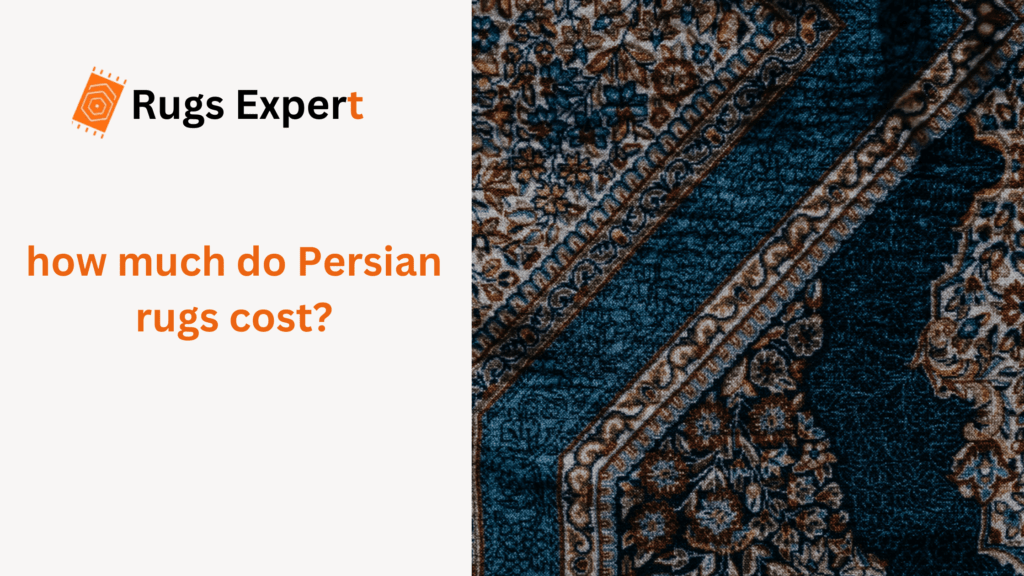
Are you wondering how much Persian rugs cost and whether they’re worth the investment? Persian rugs represent one of the world’s oldest and most cherished art forms, but their pricing can seem mysterious to newcomers.
Also Read: Best Runner Rugs for Entryway: A Complete Guide
This comprehensive guide will walk you through everything you need to know about Persian rug costs, from what drives their value to what you can expect to pay across different categories.
Introduction to Persian Rugs
Persian rugs are treasured worldwide for their beauty and craftsmanship. Let’s explore what makes them special and why they command premium prices.
What Defines a True Persian Rug
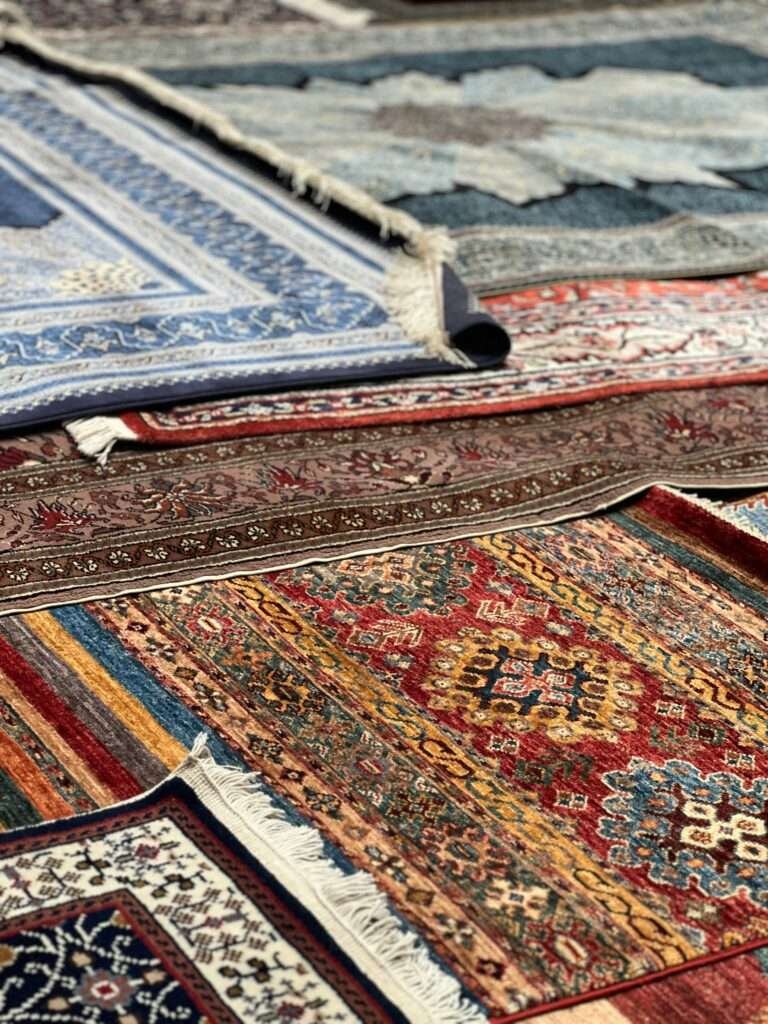
A genuine Persian rug is a hand-knotted carpet crafted in Iran. These textiles represent thousands of years of artistic tradition. Authentic Persian rugs cost more because they come from specific regions within Iran.
Also Read: Discover What is a Tufted Rug and Why It’s Popular
True Persian rugs must be hand-knotted, not machine-made. This distinction is crucial when understanding how much you’ll pay for a Persian rug.
Also Read: What is an Oushak Rug: Exploring Their Origin and Design
Historical Significance and Cultural Heritage
Persian rugs date back over 2,500 years. Throughout history, these rugs have been symbols of wealth and artistry. Persian rugs have influenced carpet design worldwide.
Also Read: Are Oriental Rugs Out of Style in Today’s Home Decor Trends?
This rich heritage directly impacts how much Persian rugs cost today. Each piece connects buyers to centuries of artistic tradition.
Why Persian Rugs Command Premium Prices
There are several reasons why Persian rug prices tend to be higher than other handmade carpets:
- Superior craftsmanship: Persian rugs feature interesting designs with exceptional attention to detail
- Time-intensive production: A single high-quality Persian rug may take months or even years to complete
- Artisanal knowledge: Techniques passed through generations create distinctive regional styles
- Natural materials: Premium wool, silk, and natural dyes contribute to quality and longevity
- Cultural significance: Their historical importance adds to their collectible value
As Dr. Walter Denny, curator at the Textile Museum in Washington, D.C., explains: “A Persian carpet represents the culmination of thousands of years of refined artistic expression and technical innovation. Their value isn’t just in their beauty but in their embodiment of cultural heritage.”
Factors Affecting Persian Rug Costs

Many elements determine how much Persian rugs cost. Below are a few factors to consider:
Age and Antique Status
The age of a Persian rug significantly impacts its price:
| Age Category | Time Period | Price Impact |
| Antique | 80+ years old | Highest premium |
| Semi-antique | 30-80 years old | Moderate premium |
| Vintage | 15-30 years old | Slight premium |
| Contemporary | Less than 15 years old | Base pricing |
Antique Persian rugs in excellent condition can fetch astronomical prices. The premium for age is substantial when calculating how much do Persian rugs cost.
Materials Used
Materials dramatically affect Persian rug cost:
- Wool: Most common material, with quality varying by source
- Silk: Costs 2-5 times more than comparable wool rugs
- Cotton: Often used for the foundation structure
- Natural dyes: More expensive than synthetic options
Material selection is a major factor in determining how much a Persian rug costs.
Knot Density and Construction
KPSI is knots per square inch:
- Entry-level: 30-80 KPSI
- Mid-range: 80-150 KPSI
- Fine: 150-250 KPSI
- Super-fine: 250-400 KPSI
- Museum-quality: 400+ KPSI
Higher knot counts mean more time creating the rug. When examining how much Persian rugs cost by quality, a rug with 300 KPSI might cost 3-5 times more than one with 80 KPSI.
Size Dimensions
Persian rug pricing scales with size:
- Small rugs/mats (2’x3′ to 3’x5′): $300-$3,000
- Area rugs (4’x6′ to 6’x9′): $600-$10,000
- Room-size rugs (8’x10′ to 10’x14′): $2,000-$25,000
- Oversize/palace rugs (12’x18′ and larger): $5,000-$100,000+
These ranges represent how much Persian rugs cost based on size, assuming average quality.
Also Read: What Size Rug for A 60-Inch Round Table? Find the Perfect Fit
Region of Origin
Different regions within Iran produce distinctive styles of Persian rugs, each with its own price implications:
- Isfahan rugs: Known for their fine weaving and intricate designs, these tend to be among the most expensive Persian rugs
- Qom silk rugs: Highly prized for their exceptional quality and elaborate patterns
- Tabriz rugs: Varied in price due to their wide range of qualities, from commercial to masterpiece-level
- Kashan rugs: Mid to high range pricing, known for their central medallion designs
- Tribal rugs (such as Qashqai, Bakhtiari): Often less expensive than city rugs but highly sought after by collectors
According to data from the Iran Carpet Company, the region of origin can create price disparities of 200-300% between rugs of similar size and quality.
Price Ranges for Persian Rugs

Understanding typical price brackets helps set realistic expectations for buyers. Persian rug costs vary widely across different quality tiers.
Entry-level Persian Rugs
Entry-level Persian rugs typically cost between $500 and $3,000. These rugs offer authentic craftsmanship at more accessible prices. They usually have lower knot counts and simpler designs.
New collectors often start with these more affordable options. These rugs still provide the beauty of Persian craftsmanship without the premium price.
Mid-range Persian Rug Pricing
Mid-range Persian rugs cost between $3,000 and $10,000. These rugs feature better materials and higher knot density. Many homeowners choose this category for everyday luxury.
These rugs offer excellent value for long-term enjoyment. The cost of a quality Persian rug in this range balances quality with affordability.
High-end and Collector Persian Rugs
High-end Persian rugs range from $10,000 to $50,000. These pieces feature exceptional artistry and materials. Serious collectors focus on this category for their beauty and craftsmanship.
The price reflects extraordinary attention to detail. How much do exceptional Persian rugs cost? The answer lies in this premium category.
Also Read: How Much Does It Cost To Ship A Rug? 5 Important Factors
Investment-grade Antique Persian Rugs
Investment-grade Persian rugs start at $50,000 and can exceed millions. These rare pieces have historical significance and impeccable provenance. These rugs often appreciate in value over time. The cost of antique Persian rugs reflects their status as investment assets.
Price Comparison by Size
Size dramatically affects how much Persian rugs cost:
| Size | Entry-level | Mid-range | High-end | Investment-grade |
| 3’x5′ | $500-$1,500 | $1,500-$3,000 | $3,000-$8,000 | $8,000+ |
| 5’x8′ | $1,000-$3,000 | $3,000-$6,000 | $6,000-$15,000 | $15,000+ |
| 8’x10′ | $2,000-$5,000 | $5,000-$10,000 | $10,000-$30,000 | $30,000+ |
| 10’x14′ | $3,500-$8,000 | $8,000-$20,000 | $20,000-$50,000 | $50,000+ |
This table helps shoppers understand Persian rug pricing by size across quality levels.
Cost Breakdown by Persian Rug Types
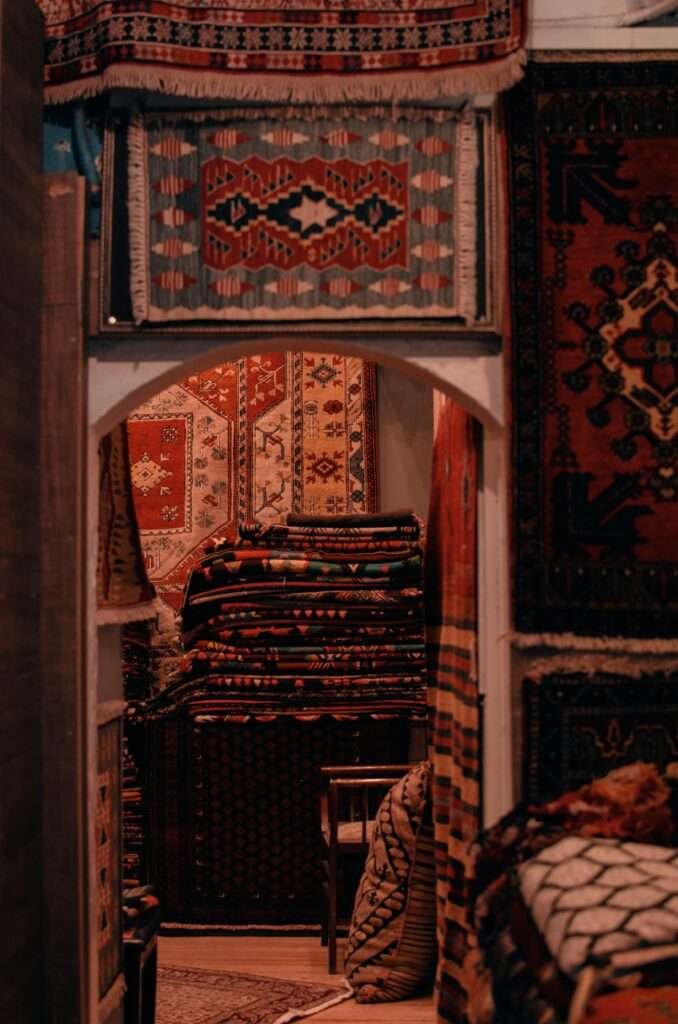
Different Persian rug styles have distinct price points. Regional variations affect how much Persian rugs cost based on their origin and characteristics.
Tabriz Rug Prices
Tabriz rugs typically cost between $2,000 and $30,000. These northwestern Iranian rugs feature intricate medallion designs. Their versatile patterns work in both traditional and modern homes.
Tabriz has been a carpet-making center for centuries. The cost of Tabriz Persian rugs reflects their refined craftsmanship.
Isfahan Rug Costs
Isfahan rugs range from $5,000 to $50,000+. These central Iranian rugs are known for extremely fine weaving. Their elaborate floral patterns showcase extraordinary skill.
Isfahan represents the height of Persian artistry. How much do Isfahan Persian rugs cost? They command premium prices for their exceptional quality.
Qom Silk Rug Values
Qom silk rugs typically cost between $6,000 and $100,000. These luxurious rugs feature silk piles and often silk foundation. Their brilliant colors and intricate designs dazzle collectors.
Qom is a relatively new rug-making center. The price of Qom silk Persian rugs reflects their status as modern masterpieces.
Nain Rug Pricing
Nain rugs range from $3,000 to $40,000. These central Iranian rugs feature delicate blue and ivory palettes. Their precise designs include signature fine blue outlines.
Nain rugs often incorporate silk highlights for contrast. The cost of Nain Persian rugs rewards their delicate beauty.
Kashan Rug Costs
Kashan rugs typically cost between $2,500 and $35,000. These traditional rugs feature bold central medallions. Their rich color palettes often include deep reds and blues.
Kashan has produced fine carpets since the 16th century. The price of Kashan Persian rugs reflects their historical importance.
Heriz and Serapi Rug Pricing
Heriz rugs range from $1,500 to $25,000. These northwestern Iranian rugs feature bold geometric designs. Their distinctive angular patterns stand out from other Persian styles.
Older Heriz rugs are sometimes called Serapi rugs. The cost of Heriz Persian rugs rewards their durability and striking appearance.
Tribal and Nomadic Rug Values
Tribal Persian rugs typically cost between $800 and $15,000. These rugs have bold geometric patterns and shiny colors. Their authentic character appeals to many collectors.
Qashqai, Bakhtiari, and Kurdish weavers create distinctive styles. The price of tribal Persian rugs often rewards their cultural authenticity.
Where to Buy Persian Rugs and Price Considerations
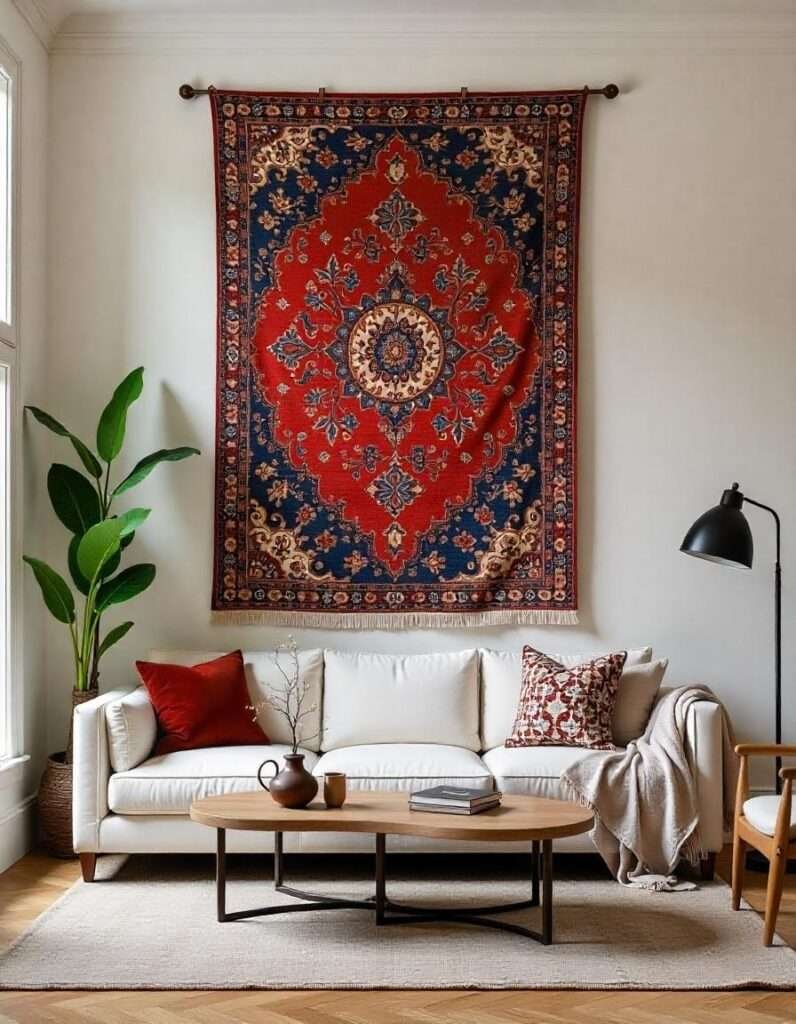
Where you buy affects how much Persian rugs cost. Different venues offer varying selection, pricing, and buyer protections.
Specialty Rug Dealers
Specialty dealers typically charge premium prices but offer expertise. They carefully select inventory and authenticate pieces. Their guidance helps buyers make informed decisions.
Also Read: 6 Best Vacuum for Oriental Rugs: Complete Buyer’s Guide (2025)
These dealers often provide guarantees and support services. The cost of Persian rugs at specialty shops includes this added value.
Auction Houses
Auction houses offer both potential bargains and record prices. They provide professional descriptions and condition reports. Important auctions attract serious collectors worldwide.
Buyer’s premiums typically add 20-25% to the hammer price. How much do Persian rugs cost at auction varies widely based on bidder interest?
Online Marketplaces
Online platforms offer convenience but require buyer caution. Established sites like 1stDibs and Chairish verify sellers. General marketplaces like eBay offer less protection.
Digital shopping expands access to global inventory. The price of Persian rugs online often falls below brick-and-mortar rates.
Direct Imports
Direct importers offer significant savings but require knowledge. These businesses cut out middlemen to reduce costs. Buyers need confidence in their own judgment.
Language and cultural barriers can complicate transactions. How much Persian rugs cost through direct imports might be 30-50% less than retail.
Estate Sales
Estate sales offer potential bargains for knowledgeable buyers. These events usually price items for quick sale. Competition can be fierce for quality pieces.
Condition assessment is crucial in estate sales. The cost of Persian rugs at these events rewards those who recognize value.
Price Negotiation Strategies
Negotiation is expected in the Persian rug market. Reasonable discounts range from 10-30% off asking prices. Building relationships with dealers can improve offers.
Timing purchases during slow seasons may yield better deals. Understanding how much Persian rugs should cost strengthens your negotiating position.
Hidden Costs of Persian Rug Ownership
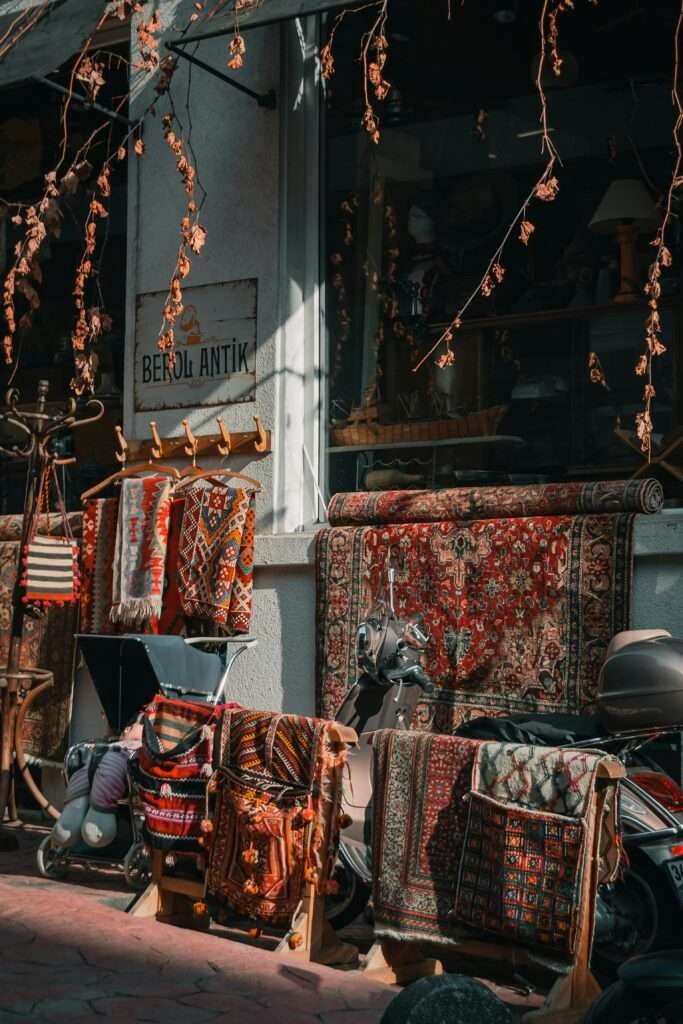
The purchase price isn’t the only cost to consider. Additional expenses affect the true cost of owning a Persian rug.
Shipping and Delivery
Shipping large Persian rugs can cost $200-$500 domestically. International shipping may exceed $1,000. Proper packaging prevents damage during transit.
Insurance during shipping is essential for valuable pieces. These costs add to how much Persian rugs truly cost the buyer.
Professional Cleaning
Professional cleaning costs $2.50-$5 per square foot. Experts recommend cleaning every 3-5 years. Proper cleaning preserves colors and extends rug life.
DIY cleaning risks damaging delicate fibers. This maintenance expense affects the long-term cost of Persian rug ownership.
Repairs and Restoration
Minor repairs typically cost $100-$500. Major restoration can reach thousands of dollars. Professional repair preserves both beauty and value.
Also Read: How to Dry a Carpet After Cleaning: A Step-By-Step Guide
Ignoring damage leads to more expensive problems later. Quality restoration is essential when calculating how much Persian rugs cost to maintain.
Insurance for Valuable Persian Rugs
Valuable rugs require specialized insurance coverage. Annual premiums typically run 1-2% of the rug’s value. Standard homeowner’s policies often have coverage limits.
Professional appraisals document value for insurance purposes. This ongoing expense protects your investment in Persian rug costs.
Appraisal Costs
Professional appraisals range from $250-$750 per rug. Updated appraisals are needed every 3-5 years. This documentation proves authenticity and value.
Appraisals become essential when selling or insuring rugs. These fees contribute to the total price of owning Persian rugs.
Proper Padding and Installation
Quality rug pads cost $1-$3 per square foot. Professional installation adds $100-$300. Proper padding prevents slipping and extends rug life.
Installation ensures proper placement and appearance. These setup costs add to the initial Persian rug price.
Are Persian Rugs Worth the Cost?
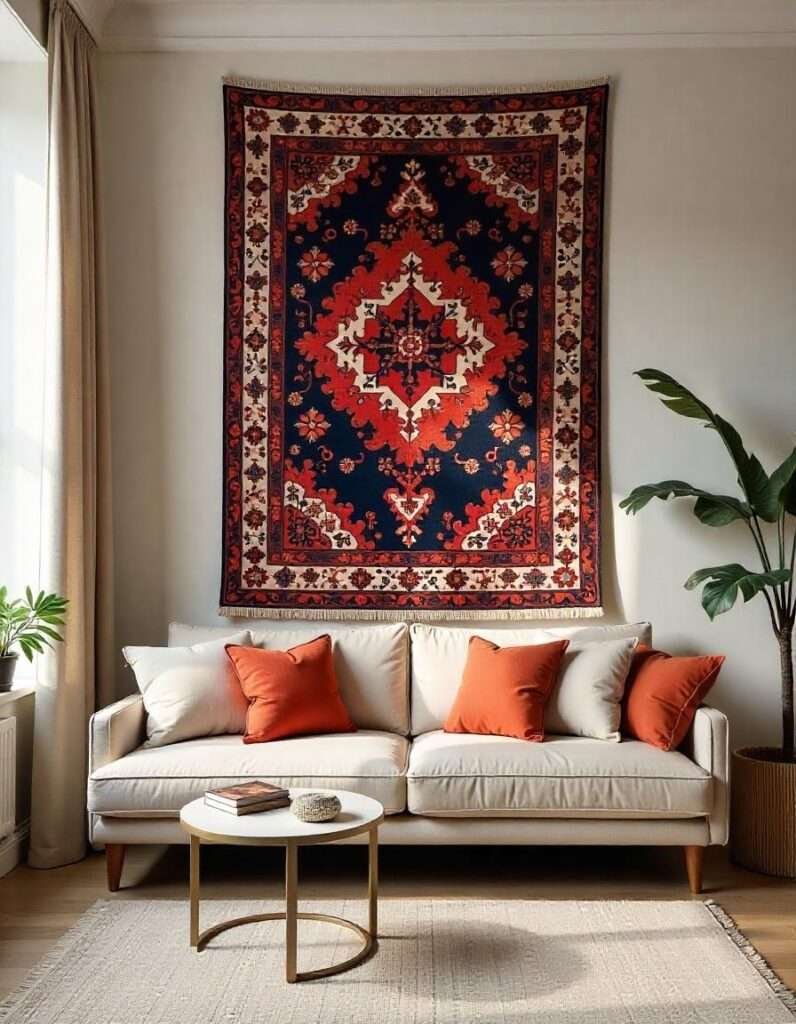
Many buyers wonder if Persian rugs justify their high prices. Several factors determine their true value proposition.
Longevity and Durability Factors
Quality Persian rugs last 50-100+ years with proper care. This longevity makes their annual cost surprisingly reasonable. Many rugs survive for generations.
Modern machine-made rugs typically last 3-10 years. The cost of Persian rugs spread over decades reveals their value.
Investment Potential
Fine Persian rugs historically appreciate 3-5% annually. Rare pieces can see much higher returns. Not all rugs increase in value, however.
Market trends affect investment performance. The price of Persian rugs as investments depends on quality, rarity, and condition.
Alternatives to Authentic Persian Rugs
Machine-made alternatives cost 10-20% of authentic Persian prices. Turkish, Indian, and Pakistani hand-knotted rugs offer lower-cost options. These alternatives provide similar aesthetics at reduced prices.
Each alternative has distinct characteristics and longevity. Understanding options helps buyers decide how much to spend on Persian rugs.
Cost-Benefit Analysis of Persian vs. Machine-Made Rugs

Consider this comparison:
| Factor | Persian Hand-Knotted | Machine-Made |
| Initial Cost | $3,000-$10,000 (8×10) | $300-$1,200 (8×10) |
| Lifespan | 50-100+ years | 5-15 years |
| Annual Cost | $30-$200/year | $60-$240/year |
| Resale Value | 70-120% of purchase | 10-20% of purchase |
| Appearance | Improves with age | Deteriorates with age |
This analysis reveals why many consider the cost of Persian rugs justified in the long term.
How to Determine if a Persian Rug is Fairly Priced
Avoiding overpayment requires knowledge. Several strategies help assess fair Persian rug pricing.
Authentication Methods
Check for hand-knotted construction on the backside. Examine knot density and pattern clarity. Authentic rugs show slight imperfections.
Natural materials feel different than synthetic fibers. These checks help verify claims about how much Persian rugs should cost.
Red Flags for Overpricing
Beware of “going out of business” perpetual sales. Question claims of massive discounts from inflated prices. Research similar rugs online for comparison.
Lack of specific information about the origin or materials signals problems. These tactics artificially inflate Persian rug costs.
Questions to Ask Sellers
Ask these key questions about any Persian rug:
- What is the exact region of origin?
- What materials make up the pile and foundation?
- What is the knot density?
- How old is the rug?
- Has it been restored?
Clear answers help determine how much Persian rugs cost at that vendor.
Resources for Price Research
Several resources help research fair pricing:
- Auction results databases
- Price guides by dealers like Nazmiyal and Doris Leslie Blau
- Museum publications
- Online marketplaces for comparison shopping
Knowledge empowers buyers to assess Persian rug price claims accurately.
FAQs
How much do Persian rugs cost on average?
Persian rugs typically cost between $1,000 and $10,000 for average sizes (5’x8′ to 8’x10′). Entry-level Persian rugs start around $500 for smaller sizes, while fine or antique pieces can cost $20,000 to $100,000+. The price varies based on size, age, materials, knot density, region, and condition.
Why are Persian rugs so expensive?
Persian rugs are expensive because they’re hand-knotted by skilled artisans, often taking months or years to complete. They use premium materials like high-quality wool and silk. Their cultural heritage, artistic value, and durability (lasting 50-100+ years) also justify their price. Authentic Persian rugs come only from Iran, adding to their exclusivity.
How much does a 5×8 Persian rug cost?
A 5’x8′ Persian rug typically costs between $1,000 and $6,000. Entry-level options start around $800, mid-range quality pieces cost $2,000-$4,000, and high-end or antique 5’x8′ Persian rugs can exceed $10,000. Silk Persian rugs of this size generally cost more than wool ones.
How much do large Persian rugs cost?
Large Persian rugs (9’x12′ and larger) typically cost between $3,000 and $30,000. Entry-level large Persian rugs start around $2,500, while fine large specimens cost $15,000-$50,000. Antique or investment-grade large Persian rugs can exceed $100,000, with palace-sized antique pieces reaching several hundred thousand dollars.
How much do silk Persian rugs cost?
Silk Persian rugs typically cost 2-5 times more than comparable wool rugs. Small silk Persian rugs (3’x5′) start around $2,000, medium sizes (5’x8′) range from $5,000 to $15,000, and larger silk pieces (8’x10’+) cost $15,000 to $100,000+. Fine Qom silk rugs command the highest prices in this category.
How much does it cost to clean a Persian rug?
Professional Persian rug cleaning costs between $2.50 and $5 per square foot. An 8’x10′ Persian rug typically costs $200-$400 to clean professionally. Experts recommend cleaning every 3-5 years. Specialized cleaning for antique or fragile rugs may cost more. DIY cleaning risks damaging valuable rugs.
How can I tell if a Persian rug is fairly priced?
To determine if a Persian rug is fairly priced, check its knot density, materials, region of origin, and condition. Compare prices of similar rugs online and at multiple dealers. Authentic Persian rugs should have hand-knotted construction visible on the backside. Be wary of “perpetual sales” and unverifiable claims about age or origin.
What’s the difference in cost between Persian and Turkish rugs?
Persian rugs typically cost 20-40% more than comparable Turkish rugs. While both feature hand-knotted construction and natural materials, Persian rugs generally command higher prices due to their finer knot density, prestigious reputation, and historical significance. Turkish rugs offer excellent quality at a somewhat lower price point.
How much do antique Persian rugs cost?
Antique Persian rugs (80+ years old) typically cost between $5,000 and $50,000 for average sizes. Museum-quality antique Persian rugs can reach prices of $100,000 to several million dollars. Factors affecting antique rug prices include age, rarity, condition, historical significance, and provenance. The most valuable pieces come from the Safavid and Qajar periods.
Conclusion: Making an Informed Persian Rug Purchase
Understanding how much Persian rugs cost helps buyers make smart choices. These timeless pieces represent both art and function.
Key Takeaways About Persian Rug Costs
Persian rug prices reflect multiple factors including origin, materials, age, and craftsmanship. Entry-level rugs start around $1,000 while fine pieces reach tens of thousands. Additional ownership costs include cleaning, padding, and maintenance.
Quality Persian rugs offer excellent long-term value. Their beauty and durability justify premium prices for many buyers.
Final Tips for Persian Rug Shoppers
Buy the best quality you can afford. Focus on rugs that speak to you personally. Learn the basics of construction and regional styles.
Work with reputable dealers who provide documentation. Consider the total cost of Persian rugs including care and maintenance.
The True Value of Persian Rugs
Persian rugs offer more than floor covering. They provide artistic beauty, cultural connection, and potential investment value. Their handcrafted nature represents human creativity and skill.
The price of Persian rugs reflects their status as functional art. For many owners, the joy these pieces bring makes them worth every penny.










